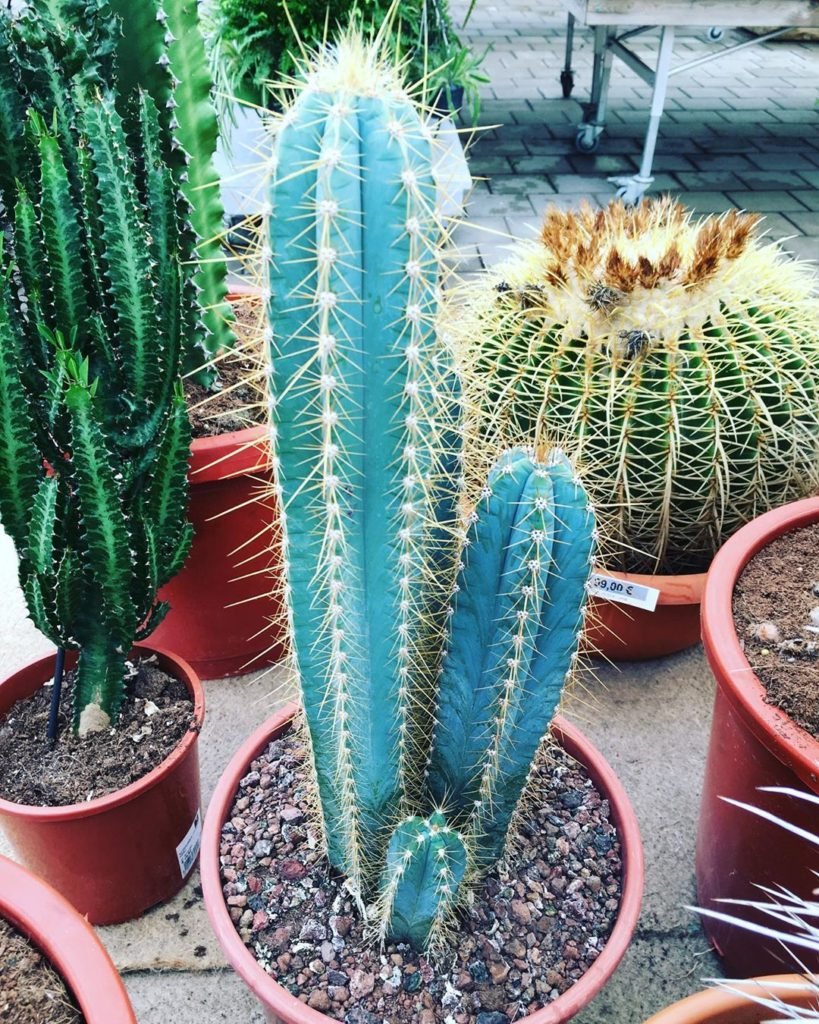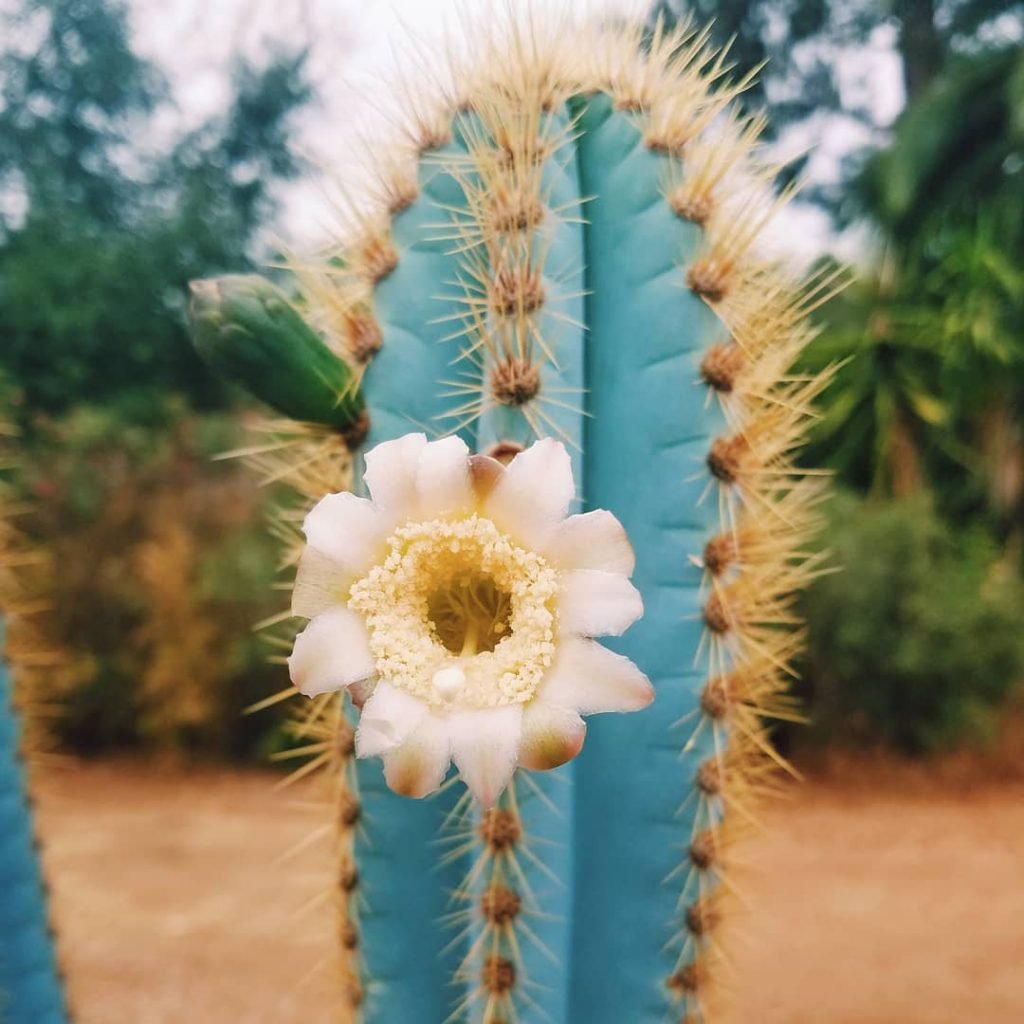Ever heard about the blue cactus? Yes, it does exist and now it is very popular on social media. Do you want to add a blue cactus plant to your garden too? Then you need to follow this article to find some colorful facts and some growing tips about this succulent.
The scientific name of this plant is pilsocereous azureus. This plant is quite famous by some weird names like blue torch cactus and blue Christmas cactus in markets.
People often ask questions like – are they real? Sometimes people even enquire about where one can find the blue cactus.
Before getting on with all these queries let us first know about the origin of this cactus. These tall columnar cacti are found originally in warm areas and places like Brazil, Mexico, and the Caribbean lands.
There are 50 different types of species of cacti existing but not a single species is as beautiful as Pilosocereus. Sounds quite interesting? You need to continue reading till the end to know more.
How to identify Blue cactus?

The hype of the blue cactus is all over social media and it is worth the hype. The color of these cacti plants is so tempting that you will fall in love at the first sight. The color itself makes the plant more attractive.
Apart from these, the blue cactus flower is also vibrant and blue in color. The Pilosocereus genus is known to have a white wool covering due to which the plant looks like a ‘hairy candle’, which is funny but makes sense.
To add to its oddness and uncommonness even its spines are colored in an orange hue.
As the plant ages, you can find the striking blue color of the stems turning more bright and developing a deeper shade of blue while the orange spines become grey.
How do you take care of colorful cactus?
By now I am quite sure you are craving to get some of these blue beauties to add some vibrant colors to your garden.
But before buying your floral friend you need to make sure you have a piece of good knowledge about how to care for a blue cactus. If you have no clue about this, let me guide you.
The process is pretty much similar to the caring process of other succulents. Let’s find out what things you have to do to keep your succulent healthy and alive.
Temperature & Light
As I have already mentioned that Pilosocereus is originally from Tropical. So, it is obvious that this plant species enjoy warm weather. The ideal temperature for its growth is 70 degrees or higher than that.
This species even enjoys direct sunlight even during the summers. Do not be afraid to keep them outside your house. Do not worry about sunburn because this plant can get adapted in its way to the outside heat.
But winter is never a suitable season to grow it. Blue cactus does not enjoy temperatures less than 50 degrees. Your plant can develop tissue damage if there is a cold snap. You can use frost cloth or grow lights to protect your plant from frosting during the winter season.
Watering & Soil
This plant enjoys more water than other succulents especially in the summers when you have to water it frequently. Be careful while watering as you must be careful not to overwater it. If the water does not drain out well the roots will rot.
This is why the soil should be enriched with gritty ingredients. A mixture of sand, perlite, and limestone can be a good option for the soil mixture because it promotes drainage and the soil dries out quickly even.
Blue barrel cactus is a water-thirsty succulent. But if you think pouring more water will help it grow massively, you are wrong. In my opinion, you should water your succulent once a week in the winter and once in a day during the summer.
You can also do a moisture test of the soil. Then you will understand how much water you should give to the plant.
Dry to average home humidity helps the blue cactus to grow. But I will suggest that you should try to water the soil rather than just misting its leaves. If the soil starts drying out, the plant will die eventually.
Fertilizer Requirements
Generally, the Pilosocereus plant grows fast, and fertilizing it will accelerate its growth even faster. In the summer, it grows really fast, so this is the best time to fertilize it. Use a water-soluble fertilizer diluted to half its strength and one that does not burn your plant.
There is no necessity to use fertilizer in the winter because the growth rate of the plant is really low. Therefore, using fertilizer is optional during this period.
If you are a gardener by your hobby and not a professional, you can entirely rely on its natural growth. But if you are a professional gardener using some effective fertilizers would be beneficial for you.
Blooming of the cactus

Before discussing about the blue cactus flowering let us know what makes cactus blue.
Cacti are the most adaptive plants and evolved very interestingly to cope with the harsh nature. It is said that the blue color is an adaptive phenomenon that makes the plant species protect themselves from harsh sunlight and discourage some pests.
Now, coming to its flowering part, if you are wondering when blue candle cacti bloom flowers, let me tell you the blue candle cactus flowers during the growing season.
The growing season is usually during the summer season and maybe sometimes in the spring and this is the time when the flowers bloom.
You must remember, uniform growth and a healthy life process for your succulent is the key to its flowering. The blue cactus needs more water and sunlight for photosynthesis. So, it is better to keep the plant outside during this time.
Propagation of Blue Cactus
Propagation is the process of growing a plant from an existing plant. Either you can buy seeds or saplings from the market or you can propagate your existing plant to get similar species that grow on their own.
If you want to learn how to propagate a plant then continue reading the points below.
Step 1:
You need to clean your cutting tools with soapy water. You should also use a disinfectant to avoid introducing any kind of diseases and fungus. Follow this process every time before cutting.
Step 2:
Blue rose cactus has many sharp spines. So, you need to wear gloves for protecting your fingers and hands. You can also use pieces of cloth or tongs according to your convenience.
Step 3:
Now you need to choose a healthy stem for cutting. Avoid those stems which have diseases or discoloration. Cut the stem with sterile knives and cutting tools.
Step 4:
Leave the cut portion for drying in the air for few days to heal the wounds. Do not leave it in direct sunlight.
Step 5:
You can also dip the cut portion in the rooting hormone. This is step is totally optional.
Step 6:
Now you need to place the cutting into the potting mix which has good drainage. You can buy it for market or you can prepare it at home by simply mixing sand, perlite or pumice, and limestone
1/3 of the cutting should be in the soil if you plant it perpendicularly. Otherwise, you can lay the cutting in the soil.
Step 7:
Water it daily for a few weeks. Mist the soil whenever it feels dry. Decrease watering after the establishment of the roots.
Step 8:
Avoid harsh sunlight during this time. Place it somewhere it could get bright sunlight. Once the roots are established place them in your garden.
Are you wondering when to prune blue agave cactus leaves? The leaves of the cactus are basically the modified stem. Summer is the ideal time to prune agave leaves. In winter the growing rate is already low for this cactus. So, it will be better to avoid the winter season for pruning.
Potting & Repotting
The last thing that you need to know about planting a blue cactus at your home is the way of potting and re-potting the cacti.
You can get a huge variety of fancy mixing pots in the market but before buying those check them carefully if they are well-draining. You can also make your own pots in your home according to your needs.
Use a good succulent mix and add 1/4 of pumice or pumice to increase drainage.
After some weeks, you should re–pot the plant because a full-grown plant needs more space to grow. And sometimes the roots of the plant are tangled up inside the pot or even growing out of the holes.
If you have not changed the soil for more than 2 years, you should re–pot it immediately because the soil loses all its nutrients over time. Here I am mentioning the steps for re-potting the blue cactus Norwalk.
- Remove the plant from the pot.
- Then remove soil from the roots very carefully.
- Place the biggest stem in the center or wherever you like to place it.
- Fill up the pot with the soil mix
Disease and Pest Control in Blue Cactus
If you are planning to grow a blue cactus in your home, you should be aware of some of the diseases it could get during its growing period. Let me list some of the common diseases here.
- Etiolation/sunburn/phototoxicity– Due to excessive exposure to sunlight.
- Desiccation– Due to lack of watering.
- Frost Damage– Due to freezing temperature.
- Pot Bound/Root Bound-Due to the absence of repotting
- Corking– Blue cactus turned brown due to the dryness and harsh sunlight.
These diseases can be easily avoided if you simply follow the previously mentioned methods.
Thrips, Aphids, Worms/Caterpillars, Nematodes, Red Spider Mites, Cochineal insects, Slugs, and snails are some of the pests that can affect the Fishbone cactus.
To keep away the bugs make a solution by mixing 3 parts rubbing alcohol with 1 part of water and dip cotton into the solution and rub it on the spots where the bugs made their colony. Instead of alcohol, you can use vinegar or apple cider vinegar as well.
Toxicity to Pets & Children
In the world of succulents and cacti, most of the cacti are non-toxic but they are not 100% safe. However, Pilosocereus is non-toxic in nature, so it’s completely safe for cats and dogs. But try to keep your pets away from the plants or they can damage them.
Though Blue cactus does not have any toxicity still you should not let your children play with it. The spines could be very dangerous for your children as well as pets. If any bugs are colonized in your plant, those could be dangerous for your children and pets too.
Where can I buy the blue cactus?
Now you must be wondering where you can purchase this over-hyped succulent. Well, although they are tough to find, luckily they are not rare and therefore you can find them with a bit of effort.
Pilosocereus are widely cultivated so there is a chance that you could find them even at local garden stores. Online stores or websites can be a great alternative to buying blue cacti.
You will find a large variety of cactus species. Some of the popular websites are enlisted below:
- Amazon
- Etsy
- Plantsguru
- Nurserylive
You will also get some amazing deals if you buy from these websites. These websites also offer free shipping.
Summary
After researching this plant, I got to know so many things about this plant and that is why I am sharing this information with you. The blue cactus plant will give you eye-soothing pleasure.
You can plant this cactus in your garden or you can gift it to someone else. This will add vibrant color to your green garden. Most importantly, the Pilosocereus species is non-toxic in nature. It will not harm your pets and children.
By now you have already gathered so much information about blue cactus and you are planning to buy one. I have made this article as informative as possible. I totally recommend you buy blue cactus.


